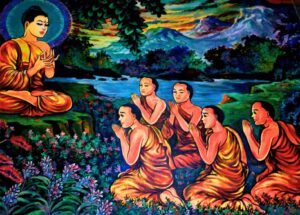Introduction
Buddha established the sangha for his followers. The sangha’s original purpose was to provide a way for practitioners who wanted to commit to full-time, rigorous penance. People who desired to devote their lives to Buddha and his teachings joined the sangha. The sangha’s monks and commoners would travel around while Buddha preached his teachings. In a ceremony, those who joined the sangha had their heads shaved to symbolize their renunciation of this life.

What is Sangha?
Sangha is simply a Buddhist social structure. Monks, nuns, regular men, women, and kids can be part of the Sangha. The sangha’s members claim to be genuine disciples of Buddha. Sangha has two meanings. One is a group of people who left their homes, desires for their families, and passions to adhere to the stringent and rigorous manner of the Buddha’s teaching. They adhere to tight rules and shave their heads to symbolize renunciation.
Sangha also has a second meaning that is connected to the Buddha. Buddha’s devotees would seek refuge with him and travel with him wherever he went. Men, women, and kids who would accompany Buddha on his journey were referred to as members of this sangha. The vows of celibacy, scarcity, and faith had to be taken by everyone who wanted to enter the sangha.
Importance of Sangha:
The sangha gained significance for devotees of the Buddha in a variety of ways:
- Buddhism is promoted by monks and laymen who joined the sangha after it was formed.
- They travel everywhere and share the Buddha’s teachings.
- People who joined the sangha had to leave their homes and families, thus for them, their community served as a place of belonging and support.
- They would frequently get together and recite Buddhist prayers and teachings.
- The rising popularity of yoga and meditation can be attributed to the sangha, a group of monks who practice both disciplines together and spread their influence wherever they go.
Buddhism is typically thought of as a solitary and isolated religion. The individual practices meditation and looks for happiness on his own. However, the Buddhist idea of sangha is the exact opposite of solitude; it asserts to create a community where everyone works toward pleasure together. The Buddha’s followers are given a sense of security and hope, and they all share the same objective.
Ancient Social Life and Sangha:
- The ancient Indian society was divided into Varnas or sections such as Brahaman, the most dominant and powerful section, Kshatriya, the warrior class, Vaishya, the merchant class, and Sudra, the labour class.
- Due to the sangha’s egalitarian culture, it rose to popularity. In the sangha, there was no varna system because Buddhism strongly disapproved of it.
- People of lower castes became equal as a result of their adoption of Buddhism. The sangha evolved into a group of equals who lived in peace and adhered to the way and teachings of the Buddha.
Buddha and Sangha
When Buddha was alive, he used to travel from place to place, teaching others, and his followers would accompany him wherever he went. Men, women, and children of all ages gathered around Buddha. The Sangha was the name given to this group of devoted Buddhist adherents who accompanied the Buddha on his journey for enlightenment, abandoning all wants and their homes in the process. This tradition persisted even after his passing, and the sangha developed into the centre of Buddhism. For Buddhism to become a religion of secular principles, the sangha was essential.
The sangha allowed participation in spreading Buddhism to each of those who sincerely adhered to the Buddha’s teachings. Sangha established a framework within which the average person might pursue his goals and follow his customs. The support of kings like Ashoka, who adopted Buddhism and spread it over the globe, played another role in the growth of Buddhism.
Summary
Buddha established the Sangha for his followers. The Sangha is simply a Buddhist social structure. Monks, nuns, regular men, women, and kids are all present. Buddhism is promoted by monks and laypeople who joined the sangha after it was formed. In the sangha, there was no varna system because Buddhism strongly disapproved of it. For Buddhism to become a religion of secular principles, the sangha was essential.
Frequently Asked Questions
1.What is the Eightfold Policy in Buddhism?
Ans. The eightfold policy of the Buddha leads to emancipation and, eventually, Nirvana. The eight ways are the right speech, the right resolution, the right vision, the right effort, the right lifestyle, the right mindfulness, and the right samadhi.
2.What is Triratna?
Ans. A Buddhist symbol, Triratna, or the Triple Jewel (Dhamma, Buddha, and Sangha), is believed to visually represent the three jewels of Buddhism. In addition to a lotus flower within a circle, the Triratna symbol is also composed of a trisula or trident with three branches and a vajra, or diamond rod.
3.What are the Four Noble Truths in Buddhism?
Ans. The four great truths are:
- Suffering
- Desire is the root of suffering
- Suffering will stop when desire ceases
- There is a way out of desire and suffering.
4.What did Buddha do After Attaining Enlightenment?
Ans. Buddha initially travelled to Sarnath to give a lecture after attaining enlightenment. After that, he travelled around to share his knowledge and his religion.
5.Who Could not Join the Sangha?
Ans. Although anyone might join the sangha, there were a few limitations. The masters had to provide their consent for the slaves to join the sangha because they were unable to do it on their own. Parents had to permit their children, and husbands had to permit their wives.